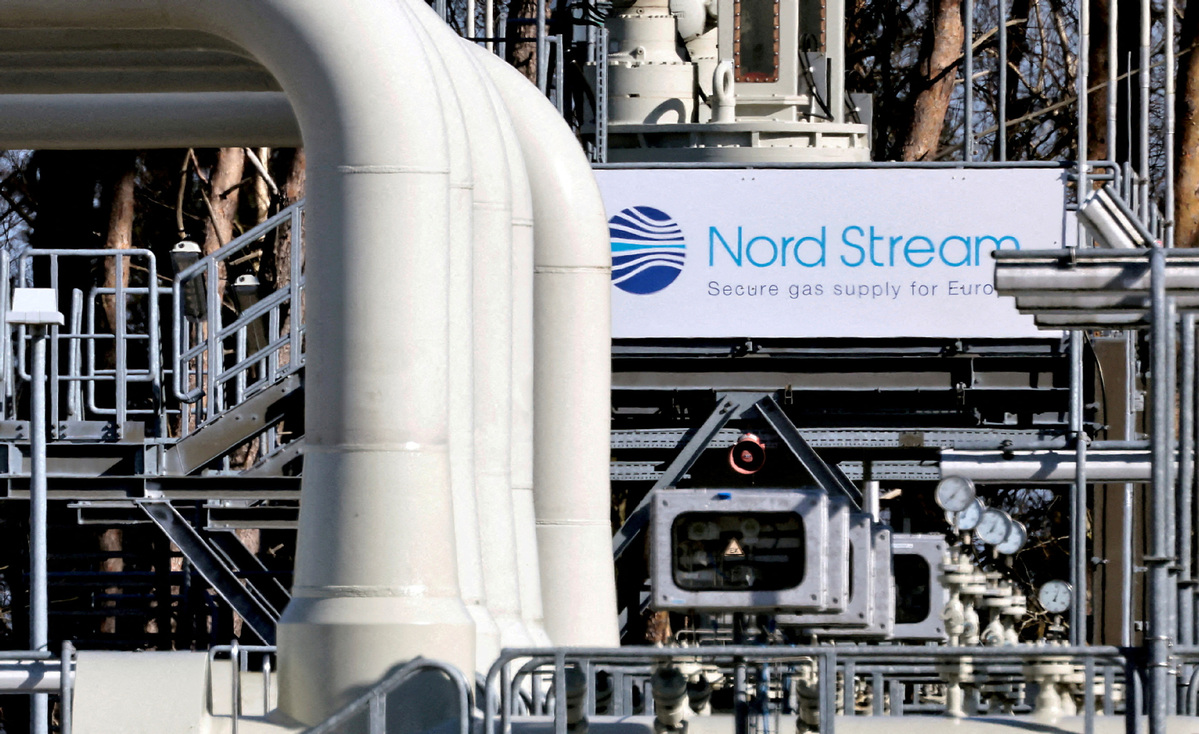FILE PHOTO: Pipes at the landfall facilities of the Nord Stream 1 gas pipeline are pictured in Lubmin, Germany, March 8, 2022. Leaders prepare for 'worst-case scenario' on fears of a total shut off Just one of five turbines is currently whirring within the Nord Stream 1 pipeline, the chief artery that pumps gas from Russia to Europe. Previously reduced capacity was once again lowered to 20 percent on Wednesday by Russia's energy company Gazprom, raising fears of a total shut off. Russia says that it is impossible to run the pipeline effectively, since foreign sanctions have delayed the repair and return of turbines, which are made and serviced abroad. As the dispute rumbles on, European leaders are preparing for a worst-case scenario involving an unprecedented prolonged cut-off of all Russian gas, which last year made up 47 percent of EU imports. "Whether it is a partial or a major cut-off of Russian gas, or a total cut-off of Russian gas, Europe needs to be ready," European Commission President Ursula von der Leyen said in a recent statement. The bloc's current strategy involves three key measures: increased supply from non-Russian sources; a reduction in overall demand, with member states agreeing to a voluntary 15-percent cut from August through March; and setting up a joint gas storage mechanism, which is currently around two-thirds full. Stores would need to reach 90 percent to get Europe through winter, according to the International Energy Agency, or IEA. "And even then, it could still face supply disruptions in the latter part of the heating season," said IEA Executive Director Fatih Birol. If supply remains low or is totally shut off, the geopolitical and economic ramifications will be significant. European nations that import comparatively little Russian gas, such as Spain and the United Kingdom, will still contend with rising costs, according to a new working paper from the International Monetary Fund, or IMF, and more exposed countries in Central and Eastern Europe could face outright gas shortages and see gross domestic product losses of as much as 6 percent. Meanwhile, gas exporters have benefited from the situation. The United States becomes the world's largest exporter of liquid natural gas, or LNG, in the first half of this year, with two thirds of exports going to Europe. "A new LNG trade, built on long-term contracts, will develop between the US and EU," David Evans, senior counsel at international law firm Clifford Chance, predicted. Sanctions disrupt supply Nord Stream 1 generally supplies about 40 percent of Gazprom's gas delivery to Europe via a pipeline that runs beneath the Nordic Sea. At the beginning of June, five turbines ran at full capacity, but a series of pay disputes and turbine issues sent capacity fluctuating, from 85 percent in mid-June, to 40 percent at the beginning of this week, with a brief maintenance period in between, when no gas ran through the pipeline. One of two functioning turbines was due to be taken off line for maintenance this week, and replaced with a newly-serviced turbine. However, the replacement did not arrive on time, meaning capacity dropped to 20 percent on Wednesday. Nord Stream 1 turbines are made by German company Siemens and serviced in Canada. Sanctions in place due to the Russia-Ukraine conflict have delayed repair and return of a turbine that was expected back in May, according to Gazprom. A key issue is how quickly Europe can substitute supply. The EU imports 47 percent of its gas and 25 percent of its oil from Russia. Put another way, the bloc imports more than one-quarter, or 26 percent, of its energy from Russia. Von der Leyen said she is in talks with Qatar, Algeria, Egypt, and Azerbaijan over increasing fossil fuel imports, and, meanwhile, both Norway and the US have significantly upped supply. Authors of the IMF paper estimate that Europe could replace up to 70 percent of Russian gas imports with alternatives for a period of six months. However, a longer full shut-off would likely produce very high prices and significant shortages in some countries. Hungary, Slovakia and the Czech Republic could face shortages equivalent to 40 percent of gas consumption and GDP shrinkage of up to 6 percent, according to the IMF paper. Climate pledge at risk To minimize gas use in the power sector, the IEA's Birol said that European nations will have to temporarily increase coal and oil-fired generation. At the United Nations Climate Change Conference, or COP26, in Glasgow last November, UN member states agreed to phase down use of coal. Clifford Chance's Evans expects that these efforts will be put on hold. "Some fossil-based substitute for Russian fossil fuel is needed, especially for industrial uses that will take longer to decarbonize," Evans said. Europe's thirst for new sources of fuel has already created a "global gold rush for new fossil gas production", according to the Climate Action Tracker. Canada has plans to fast-track new LNG projects, domestic production has increased in the US, Norway, Italy and Japan, and Nigeria has revived old gas pipeline projects, while Senegal is seeking to export gas to Europe for the first time.
Europe scrambles to address gas crisis
Editor:谭婕倪
Source:China Daily
Updated:2022-08-01 09:41:05
Source:China Daily
Updated:2022-08-01 09:41:05
Special
Contact
Welcome to English Channel! Any suggestion, welcome.Tel:0731-82965627
lisl@rednet.cn
zhouqian@rednet.cn











